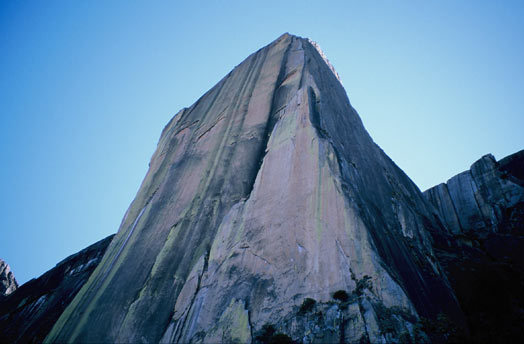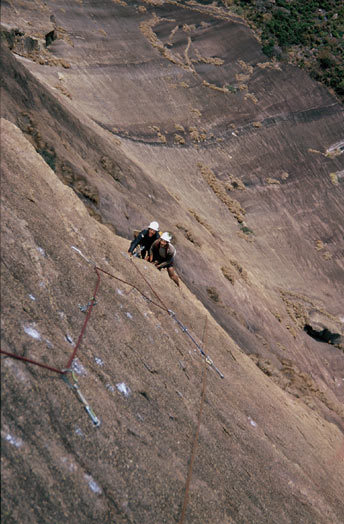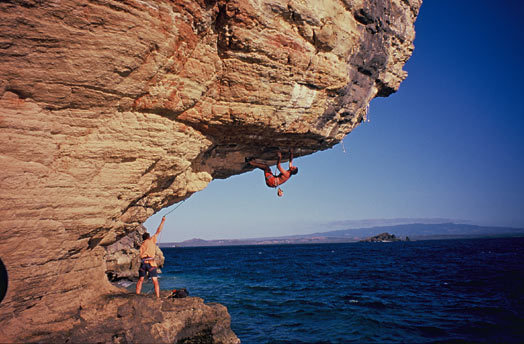
The 420-meter northeast arete of Karambony in Madagascar’s Tsaranoro Massif in Andringitra National Park. Rain Boto (7b+, 10 pitches, 420m) takes the arete direct. Always the Sun (7c+, 7b obl., 450m) is on the wall to the right of the arete. These and other hard Tsaranoro Massif routes received notable ascents this autumn, with British climbers Gaz Parry and John Arran onsighting Rain Boto, and French climber Denis Roy onsighting both Rain Boto and Always the Sun. [Photo] Jerry Gore
In September and October, Madagascar’s Tsaranoro Massif in Andringitra National Park of southern Madagascar received visits from a number of Europeans (including an impressive visit by Ondra Benes and Tomas Sobotka from the Czech Republic, detailed here). The British team of John and Anne Arran, Gaz Parry, Giles Cornah and Jerry Gore was one of the groups on the scene, as was the French-Polish team of Pierre Muller, Denis Roy, Marie-Claire Hourcade and David Kaszlikowski. All managed notable outings on some of the finest routes of the Massif.
On their first day in the park the Brits (all of them) climbed Out of Africa (7a, 580m)–“fourteen pitches of superb granite slabs offering the best flakes, chickenheads and big crystal climbing any of us had ever experienced,” reported Gore.
Next up was the British extreme classic Always the Sun. Established in 1999 by Twid and Louise Thomas, Grant Farquar and Steve Meyers, the route offers eight pitches up to 7c+ on a 400-meter, smooth granite face that offers “better than gritstone” friction. A very much “on form” Gaz onsighted all the hard pitches, including the top (crux) pitch, commenting “imagine climbing a 7c+ route with no handholds!”
With the team now fully accustomed to the rock, the Brits proceeded to squeeze full value from their trip. Parry and John Arran onsighted Rain Boto (7b+, 10 pitches, 420m), and the entire team made an ascent of Le Crabe aux Pinces D’Or (7b+, 11 pitches, 320m), with Parry and John Arran onsighting the crux pitches. The latter two also made an ascent of Bravo Les Filles (8b, 15 pitches, 600m, Feagin-Hill-Rodden-Pyke, 1999), missing the redpoint by one pitch, the crux, which John Arran described as “a minging, bouldery crux … that’s very hard and out of character with the rest” of the climb.
For their finale, the Brits turned their attention to the Massif’s longest and most demanding route: Gondwanaland (7c, 7a obl., Botte-Cola-Egger-Gargitter- Obojes-Obrist-Thaler Trenkwalder-Zanesco, 1996), on the 800-meter east face of Tsaranoro Be. Gondwanaland offers twenty pitches up to 7c, including a killer mid-section comprising eight continuous pitches of 7a/7b climbing on expanding flakes and numerous runouts up to ten meters between bolts. The climb, put up in 1996 or 1997 by climbers from the South Tyrol, offers delicate climbing on insecure slabs with dangerous fall potential protected by hand-drilled six- and eight-millimeter steel bolts, some of which had rusted.
Borrowing Polish climber David Kaszlikowski’s drill (“much better than ours”), Jerry Gore spearheaded an effort to partially re-equip the route. John Arran writes, “Generally only the belays were rebolted, with a new ten-mil stainless [bolts] added to each existing two-bolt belay. Our team chose to replace only a handful of on-pitch bolts; the rest seeming pretty much fine.” Gaz, Giles and Gore climbed the route as a threesome, followed by John and Anne Arran, who shared leads and climbed every pitch either onsight or redpoint.

Looking down at Gaz Parry and Giles Cornah at the belay of Pitch 14 (7a), Gondwanaland (7c, 7a obl., Botte-Cola-Egger-Gargitter-Obojes-Obrist-Thaler Trenkwalder-Zanesco, 1996), on the 800-meter east face of Tsaranoro Be., at the belay. After a rebolting effort to replace some suspect in situ gear, the route received a redpoint ascent by John and Anne Arran, and an eight-hour onsight, by Denis Roy. [Photo] Jerry Gore
The following day the Brits had a goodbye party, which French climbers Denis Roy and Pierre Muller attended. Roy and Muller eventually got to sleep around 1 a.m., then got up at 3 a.m. to start for Gondwanaland. With extensive beta from the Brits (and on a now well-chalked route), Denis onsighted the entire route in eight hours.
This accomplishment was one of many for Roy, who, accompanied by Muller, also onsighted the following routes during the Polish-French stay: Rain Boto (7b+, 7b obl., 420m) in six hours; Always The Sun (7c+, 7b obl., 450m) in six hours; Le Crabe aux Pinces d’Or (7b+, 6c+ obl., 320m), in five hours; and Out of Africa (7a, 6c oblig., 600m).
Meanwhile, the team of Kaszlikowski and Hourcade redpointed Life In the Fairy Tale (7a, 500m); Le Crabe aux Pinces d’Or and Out of Africa (onsight), and a number of other easier routes (they also climbed most of Rain Boto but rappelled before the finish).
The majority of the pitches of all these routes is harder than 7a and on many 30-meter sections the first ascentionists used only four (sometimes even only two) bolts without a possibility of natural protection. The granite in the Tsaranoro massif requires delicate, technical climbing on tiny and often fragile holds.
After their Tsaranoro massif romp, the Polish-French team joined the Brits on the north end of Madagascar where, apart from climbing many easy routes both on-land at Montagne Des Francais and off-shore on the tiny islands of Nosy Anjombalova and Nosy Andantsara, Roy onsighted Ale Baba (8a+) and Perfection (8a), John Arran flashed the second hardest route on the islands, Tafo Masina (8a) on Nosy Anjombalova, and Gaz Parry made the first free ascent of Madagascar’s hardest route, Route de Rhum (8b) on Nosy Andantsara. The French-Polish team prepared a movie about climbing in Madagascar produced by Denis Roy’s Totem Pole studio (more info soon on www.totempole.fr).

Gaz Parry redpointing the first free ascent of Madagascar’s hardest route, Les Nuafrages Du Rhum (8b), on the island of Nosy Andantsara. [Photo] Jerry Gore